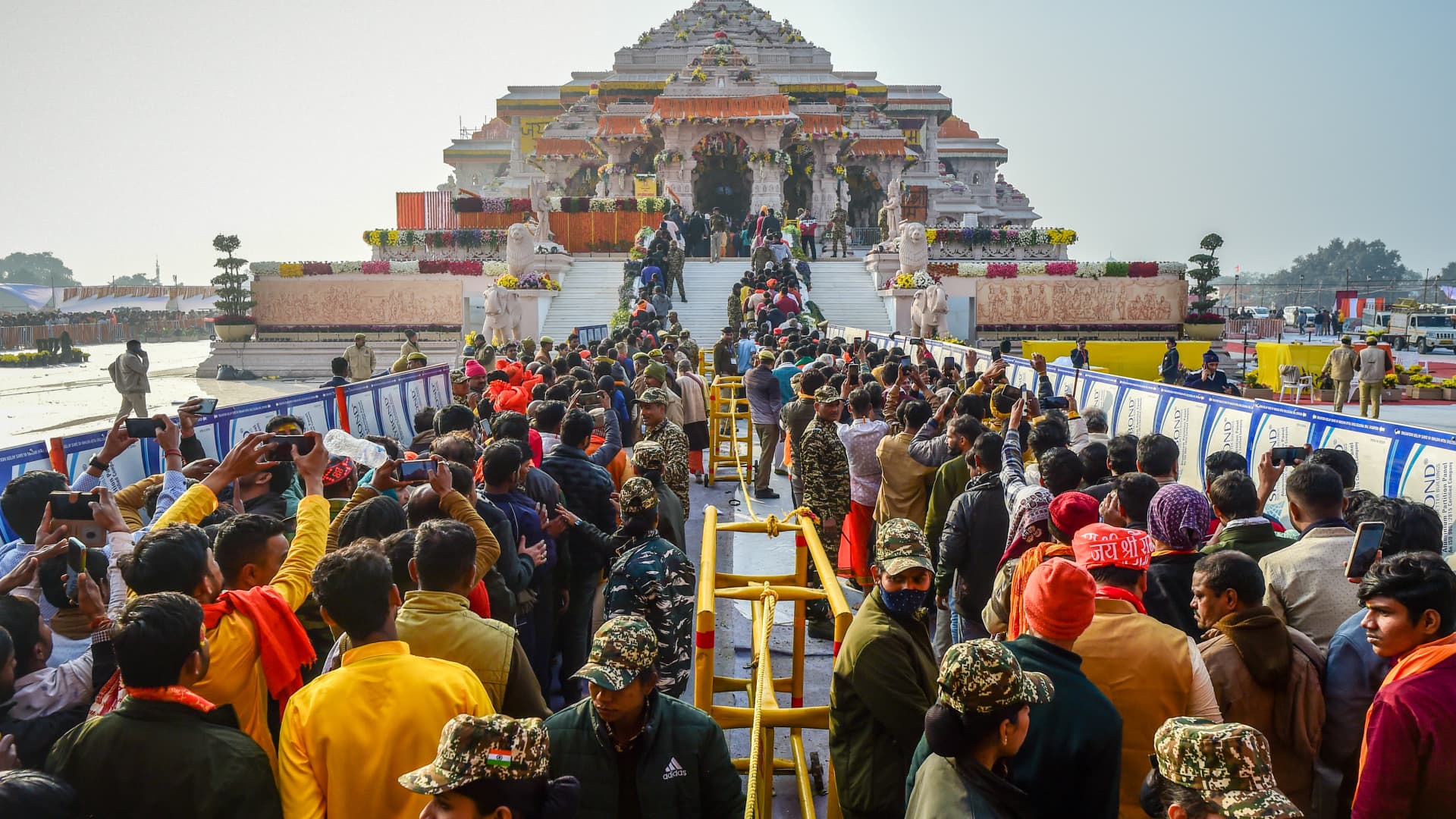India’s tourism sector is set for a boom as more travelers take trips around the country for religious purposes.
The South Asian country with the world’s largest Hindu population could see an additional 50 million to 100 million tourists a year on account of the new Ram Mandir — a temple in the northern city of Ayodhya inaugurated on Monday — according to Jefferies.
This expected footfall in the new temple will be much higher than the annual numbers for the Taj Mahal (6.5 million) in India, Rome’s Vatican City (9 million) and the Mecca in Saudi Arabia (20 million), the note showed.
Other religious sights in India such as the Tirupati Temple in Andhra Pradesh — 25 million visitors annually — and the Vaishno Devi Temple in Jammu and Kashmir — 8 million visitors per year — also hold a strong spiritual, historical and cultural significance in India, the investment bank said.
“Religious tourism is still the biggest segment of tourism in India … the creation of a new religious tourist centre (Ayodhya) with improved connectivity and infrastructure can create a meaningfully large economic impact,” Jefferies highlighted.
Indian media reported that around half a million people visited the Ram temple on its opening day which was inaugurated by Prime Minister Narendra Modi. The YouTube broadcast of the opening ceremony on Modi’s channel alone received more than 11 million views.
“The multiplier effect of travel is humongous. If it continues develop tourist destination including religious tourism, chances are that more and more people will come to visit India and it will even benefit on the foreign exchange side,” said Nilesh Shah, managing director at Kotak Mahindra Asset Management.
India saw 10.93 million foreign tourists in pre-pandemic 2019, and 6.43 million between January and September last year, according to the Press Information Bureau.
The world’s most populous country is set to be the fourth-largest global spender on travel by 2030, with travel and tourism predicted to become a $410 billion market — a surge of more than 170% from $150 billion in 2019, Booking.com data showed.
“India has a lot to offer to all kinds of travelers, from beaches to historical landmarks, backwaters to spiritual locations,” Santosh Kumar, country manager of India, Sri Lanka, Maldives and Indonesia for Booking.com said.
“The government is encouraging the promotion of domestic tourism, while also working towards improving cleanliness, focusing on water conservation, promoting locally made products and adopting digital methods … for locals and tourists alike,” Kumar told CNBC via email.
Air travel takes off
Indian carriers have placed orders for more than 1,100 planes over the past eight months, signaling massive demand for travel.
Indigo in June last year placed the biggest commercial aircraft order in history for 500 Airbus A320 aircraft which will be delivered between 2030 and 2035, topping Air India’s deal to purchase 470 planes from Airbus and Boeing the same month.
Akasa Air last week ordered 150 Boeing 737 MAX planes.
India’s improving air and road connectivity has made travel easier and helped push sector-wide growth.
Air India Express, owned by Air India, has announced direct flights to Ayodhya from Bengaluru, Kolkata and Delhi. Low-cost carrier IndiGo too has announced direct flights to the holy city from Delhi, Ahmedabad and Mumbai.
The Atal Setu, India’s longest sea bridge spanning 21.8km, was opened earlier this month to reduce travel times between cities and improve connectivity between Mumbai International Airport and the Navi Mumbai International Airport.
All this is a blessing for the hospitality industry.
Hospitality names such as Indian Hotels Company Limited and OYO Rooms, and fast-moving consumer goods companies including Hindustan Unilever, Jubilant Foodworks and Britannia Industries are all set to benefit from the boom in Indian tourism, Jefferies said.
“In addition to traditional hotel settings, Indians are increasingly look for accommodations such as apartments, villas, homestays and other unique places to stay,” Booking.com’s Kumar said, citing the firm’s ‘How India Travels 2023’ report.
— CNBC’s Naman Tandon contributed to this report.
